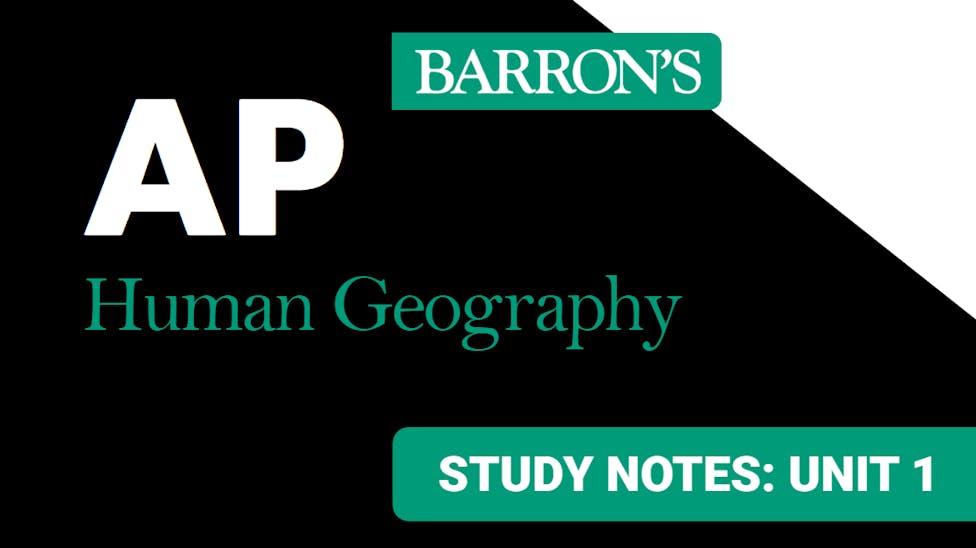AP Human Geography Unit 1: Thinking Geographically Notes
April 9, 2024

There’s a huge amount of information to digest as you prepare for the AP Human Geography Exam. We’ve compiled concise unit summaries and key terms to help you organize your thoughts and prepare for the AP Human Geography test. Read on for our summary and key terms for AP Human Geography Unit 1.
AP Human Geography: Unit 1 Summary
Human geography is the study of human activities on Earth’s surface. Since the first scholars began studying geography some 3,000 years ago, the field has matured into an important and wide-ranging area of academic and applied research. One thing that binds all geographers together is the spatial perspective. Looking at Earth from a spatial perspective means looking at how objects, processes, and patterns change over the earth’s surface. Geographers describe these variations by creating visual representations of spatial data in the form of maps. All maps are based on a projection. They have a characteristic scale and resolution. All maps use symbols to depict spatial information. Geographers use a diverse set of concepts, tools, technologies, and mathematical equations to study places, regions, and the processes that link them. In general, places that are closer to each other in absolute distance tend to interact more. However, the interaction among places is also determined by the size of each place, their level of connectivity, and the diffusion processes that carry information and cultural traditions from one place to another.
AP Human Geography: Unit 1 Key Terms
- Absolute distance: A distance that can be measured with a standard unit of length, such as a mile or kilometer.
- Absolute location: The exact position of an object or place, measured within the spatial coordinates of a grid system.
- Accessibility: The relative ease with which a destination may be reached from some other place.
- Aggregation: To come together into a mass, sum, or whole.
- Anthropogenic: Human-induced changes on the natural environment.
- Azimuthal projection: A map projection in which the plane is the most developable surface.
- Breaking point: The outer edge of a city’s sphere of influence, used in the law of retail gravitation to describe the area of a city’s hinterlands that depend on that city for its retail supplies.
- Cartograms: A type of thematic map that transforms space such that the political unit with the greatest value for some type of data is represented by the largest relative area.
- Cartography: The theory and practice of making visual representations of Earth’s surface in the form of maps.
- Choropleth map: A thematic map that uses tones or colors to represent spatial data as average values per unit area.
- Cognitive map: An image of a portion of Earth’s surface that an individual creates in his or her mind. Cognitive maps can include knowledge of actual locations and relationships among locations as well as personal perceptions and preferences of particular places.
- Complementarity: The actual or potential relationship between two places, usually referring to economic interactions.
- Connectivity: The degree of economic, social, cultural, or political connection between two places.
- Contagious diffusion: The spread of a disease, an innovation, or cultural traits through direct contact with another person or another place.
- Coordinate system: A standard grid, composed of lines of latitude and longitude, used to determine the absolute location of any object, place, or feature on Earth’s surface.
- Cultural ecology: Also called Nature-Society Geography, the study of the interactions between societies and the natural environments in which they live.
- Cultural landscape: The human-modified natural landscape specifically containing the imprint of a particular culture or society.
- Distance Decay Effect: The decrease in interaction between two phenomena, places, or people as the distance between them increases.
- Dot maps: Thematic maps that use points to show the precise locations of specific observations or occurrences, such as crimes, car accidents, or births.
- Earth system science: A systematic approach to physical geography that looks at the interaction between Earth’s physical systems and processes on a global scale.
- Environmental geography: The intersection between human and physical geography, which explores the spatial impacts humans have on the physical environment and vice versa.
- Expansion diffusion: The spread of ideas, innovations, fashion, or other phenomena to surrounding areas through contact and exchange.
- Formal region: Definition of regions based on common themes such as similarities in lan- guage, climate, land use, etc.
- Friction of distance: A measure of how much absolute distance affects the interaction between two places.
- Fuller projection: A type of map projection that maintains the accurate size and shape of landmasses but completely rearranges direction such that the four cardinal directions— north, south, east, and west—no longer have any meaning.
- Functional region: Definition of regions based on common interaction (or function), for example, a boundary line drawn around the circulation of a particular newspaper.
Check out the rest of our AP Human Geography Unit 1 Key Terms.
AP Biology Resources
- About the AP Biology Exam
- Top AP Biology Exam Strategies
- Top 5 Study Topics and Tips for the AP Biology Exam
- AP Biology Short Free-Response Questions
- AP Biology Long Free-Response Questions
AP Psychology Resources
- What’s Tested on the AP Psychology Exam?
- Top 5 Study Tips for the AP Psychology Exam
- AP Psychology Key Terms
- Top AP Psychology Exam Multiple-Choice Question Tips
- Top AP Psychology Exam Free Response Questions Tips
- AP Psychology Sample Free Response Question
AP English Language and Composition Resources
- What’s Tested on the AP English Language and Composition Exam?
- Top 5 Tips for the AP English Language and Composition Exam
- Top Reading Techniques for the AP English Language and Composition Exam
- How to Answer the AP English Language and Composition Essay Questions
- AP English Language and Composition Exam Sample Essay Questions
- AP English Language and Composition Exam Multiple-Choice Questions
